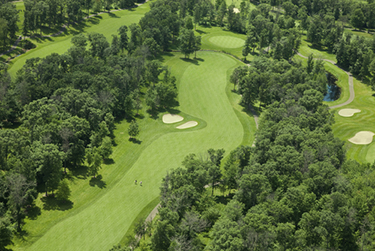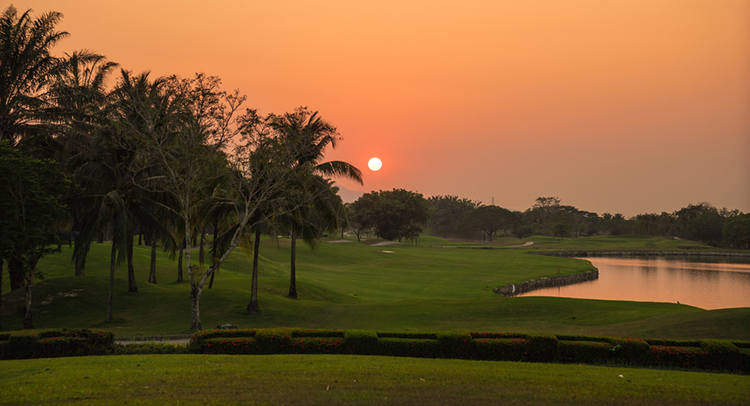Top 10 Most Celebrated Golf Courses in America
Jul 27th 2017

Today, thousands of golf courses dot the American coastlines and countryside.
While golf’s rich heritage ensured the mass proliferation of both challenging and scenic venues, a few courses have ascended to special heights in the public’s eye.
As golf culture continues to evolve—to introduce broader demographics and positive changes to the game itself—these select courses continue to beckon players, visitors, and storytellers alike. Together, they comprise the linchpins of a vast latticework of American golf courses, the backbone of golf’s landmarks.
Ultimately, ten courses remain particularly celebrated throughout golf—for a host of different reasons—and an examination into each of these courses hints at the grandeur and success of American golf. Perhaps they also provide the signposts of golf’s future.

AUGUSTA NATIONAL GOLF CLUB
Since its design in 1933, Augusta National Golf Club has remained the most publicized course in American history, serving as the annual host for the Masters Tournament—the only major hosted at the same golf course every year.

Located in Augusta, a city just off the Savannah River in Georgia, this golf club provides an influx of some 200,000 tourists to a city known for its humid, subtropical environs. The city of Augusta shares similar historical roots to the golf course, as both have been entangled in various civil rights efforts over the past century. Augusta is Georgia’s second oldest city and is home to Master’s Golf Tournament, and was President Woodrow Wilson’s childhood home. The Morris Museum of Art in Augusta houses the country’s largest collection of Southern art.
Curiously, Augusta National Golf Club has also served as a proverbial battleground for divergences in golf philosophy and course architecture.
While initial course designs offered players a more traditional ground game—where players must read slopes surrounding the green and roll their balls to the desired position—significant changes have been made to the course over the years.
A large majority of these changes stemmed from efforts to protect par, the byproducts of which resulted in increased bunker placement surrounding the greens. These changes to Augusta National continue to prompt discussion as to the most beautiful style of golf—whether an ability to read the terrain, utilize the ground’s natural slopes, and control the ball’s precise trajectory, in fact, adds another dimension to the game. Seventy-five years after its opening, Augusta National now offers a notoriously limited ground game—a large departure from its infant contours.
The course’s success in attracting many American luminaries serves as a testament to its cherished position in golf lore. Augusta National sports a membership comprised of decorated contributors in a variety of fields, including Jack Nicklaus, Bill Gates, Warren Buffett, and Condoleezza Rice. Going forward, Augusta National will continue to remain the pinnacle of national golf venues.

OAKMONT COUNTRY CLUB
Like Augusta National, Oakmont Country Club also presents a significant challenge to golfers. Since its founding in 1903, it has been considered the oldest top-ranked golf course in the U.S.—thwarting golfers throughout that period.

This course, nestled into the Plum suburbs of Pittsburgh, Pennsylvania, has also played host to the U.S. Open nine times, which is the most of any course. The small town of Plum houses a relatively small contingent of residents. Similar to Augusta, it has received significantly more tourism because of the local golf club that has been consistently ranked as one of the best by Golf Digest.

PEBBLE BEACH GOLF LINKS
Pebble Beach Golf Links represents one of the most picturesque golf courses in America. With holes sprawled along a small peninsula jutting out from the coastline of California, breathtaking views of the Pacific Ocean and Carmel Bay provide the backdrop for every shot. Naturally, such a course also presents a high degree of difficulty.
Located in Pebble Beach, a small town just outside Monterey, this swathe of land became particularly prominent with the rise of the famous 17-Mile Drive—a scenic travel route for visitors to appreciate the historic coastal views. This beautiful golf course gained further notoriety when Golf Digest named it as the #1 Golf Course in America, making Pebble Beach the first public course to earn such a distinction. Public access—combined with the incredible surrounding landscape—has made this course a destination for amateur and professional golfers alike.


CYPRESS POINT CLUB
Cypress Point Club, like the course in Pebble Beach, also sits on California’s Monterey peninsula. This area plays home to diverse wildlife, as large portions of the Monterey Bay have become protected marine areas to aid in the conservation of aquatic ecosystems and ocean habitats.
While Cypress Point Club occupies a relatively small area of land—the course is only 6,536 yards long—it offers perhaps the most legendary hole in the game of golf. On the 16th hole, golfers must shoot over a sizeable portion of the Pacific Ocean.
Considering both Pebble Beach Golf Links and Cypress Point Club, the Monterey peninsula has become a hotbed of golf activity—and a necessary trip for any serious golfer.

THE INTERNATIONAL (THE PINES)
Located in Bolton, Massachusetts, a residential and agricultural community on the east slope of the Nashua River Valley, The International has retained the mantle of being the longest course in the U.S. since 1957. The sheer numbers that a golfer must grapple with are daunting: a whopping 8,325 yards, an unusual par-73, and an astronomically high course rating of 80. Most golf courses fall well short of 7,000 yards, but The International mocks such designs.
The details of the course reveal how it accumulates such a reputation: a bevy of 600+ yard par-5’s, a rare par-6 that stretches well over 700 yards, and a par-3 of almost 300 yards. These distances make it almost impossible for the average golfer to reach the green in regulation. Even then, the greens exist as great expanses of golf’s folly: the green on the par-6 stretches 91 yards—almost a football field—and takes over an hour to mow. This length turns the dreaded 3-putt into a comically admirable goal.

When courses stretch like this, only the reckless would attempt to traverse the course on foot. All reserves of energy must be rationed to effectively grapple with the elongated form of golf itself. Thus, a golf cart becomes a necessity. The drive itself presents something of miniature road trip, so golf carts with engines both powerful and quiet are the preference.

PINE VALLEY GOLF CLUB
In keeping with the theme of courses located in picturesque, quiet communities, Pine Valley Golf Club sits nestled in a borough of Camden County, New Jersey and has more golf holes than residents. The 12 residents in the Pine Valley borough represent the second-smallest municipality in New Jersey.
Over the years, Pine Valley Golf Club has rivaled Augusta National for the distinction of best course in America—and it rivals The International course regarding its intimidation.
While most courses present scenic greenery with a sprinkling of sand traps and hazards, Pine Valley appears something closer to a desert with patches of grass added out of comical relief and pity. The course sports hazards such as “Hell’s Half Acre,” as well as maniacal icepick-shaped bunkers like “D.A.” on the par-3 10th hole—the “D” standing for devil.
Henry Longhurst, a famous British golf writer and correspondent, wrote a fitting description of Pine Valley’s challenges: “Your ball is either on the fairway, in which case it sits invitingly on a flawless carpet of turf, or it is not. If it is not, you play out sideways till it is.” This combination of dizzying challenge and flawless course maintenance continue to make Pine Valley Golf Club a treasured component of golf’s many venues.

WINGED FOOT GOLF CLUB (WEST)

The town of Mamaroneck in New York provides the land for Winged Foot Golf Club (West). Mamaroneck contains two villages, and both have become particularly popular residential areas. In fact, Mamaroneck ranked first among the top ten places to live in New York State, according to the major national real estate brokerage Movoto.
Winged Foot Golf Club (West) itself provides a singularly unique attraction in Mamaroneck, as it has a habit of making even the best professionals look mediocre. In the 2006 U.S. Open, the winning score was a seemingly dismal five-over-par—about 15 strokes behind the average winning score for a major tournament.
With tree-lined fairways, dense rough, and greens perched on elevated plateaus of land, Winged Foot Golf Club (West) remains both celebrated and detested within the golf community.

WHISTLING STRAITS
Whistling Straits represents the first of two golf courses on this list designed by Pete Dye, a renowned golf course architect—and the source of much frustration for competitive golfers.
Whistling Straits sits in Sheboygan County, Wisconsin, in an area that has now become a resort, but which once held a much more sinister function. When Dye was presented with the opportunity to repurpose this desolate Army bombing range along the coast of Lake Michigan, he peppered the field with more land mines than even its previous purpose supplied.
Allegedly, Dye’s wife encouraged him to devise holes that would register even the professionals with double bogeys. Dye certainly did not disappoint, gracing the course with hundreds of bunkers ranging in size all the way up to unwieldy 70-foot dunes.
The “Dye-abolical” 18th hole represents the pinnacle of Pete’s deviance, as a downhill entry shot to a sliver of a green—amid the hole’s usually swirling winds—presents a climactic finale to any round.

THE OCEAN COURSE
In a comically cruel attempt to pad his reputation, Pete Dye then embarked on designs for the most challenging golf course today: The Ocean Course. Golf Digest ranks it as the toughest course in the U.S.—a declaration based not only on cumulative hole length, but also on the course’s hazards and “slope rating.”
The Ocean Course possesses the maximum slope rating of 155, and golfers must hit arcing shots over a bevy of marshes and bunkers to have any success. Even then, Dye gets the last laugh, as the course employs a variety of roll-resistant Bermuda grass. Thus, after a series of professional casualties during the Ryder Cup in 1991, the course now carries a fitting nickname: Looney Dunes.

While portions of the playing season necessitate walking on this course, navigating the jagged ground with a golf bag is no small feat. Consequently, it is advised the average player utilize a golf cart—especially one equipped with LED or halogen light accessories—to effectively navigate the bipolar gradient of peaks and valleys. Then, on the off-chance a standard round turns into a grueling affair, at least players won’t have to worry about the lifespan of their light bulbs.
In contrast to its cruel nature, The Ocean Course occupies a lovely strip of land on Kiawah Island, South Carolina—just southwest of the charming and historic city of Charleston. The course remains the primary attraction of the Kiawah Island Golf Resort, an inviting oasis with shoreline views of the Atlantic Ocean. As Americans increasingly retire to the Carolinas—with Charleston being a particularly popular destination—The Ocean Course continues to provide its unique combination of twisting landscape, swirling winds, and golf paradise.

THE SNEAD COURSE (GREENBRIER RESORT)
When the Snead Course debuted in 2004 as a part of the Greenbrier Resort in West Virginia, it became one of the top private golf courses in the U.S.
However, the Greenbrier Resort has a curious, hidden history of its own: It houses a now declassified bunker—a bunker designed as an emergency Cold War fallout shelter should Congress need to relocate. The shelter remains wedged deep into the heart of the Appalachian mountainside, attracting many tourists.
Like the Kiawah Island Resort, the Greenbrier Resort also plays host to a handful of different courses. The Snead Course holds a particularly special place in the hearts of golfers. Legendary golfer Sam Snead passed away in 2002, and this golf course aims to commemorate his legacy.
Sam Snead shaped golf more than almost anyone else, winning a record 82 PGA Tour events and inspiring generations of new golfers over the years. While golf was born in 15th century Europe, it reached maturity in the U.S. with Sam Snead. Every round played on The Snead Course serves as a small tribute to an architect of the game.
FINAL THOUGHTS

Ultimately, each of these courses offers a unique playing experience for interested parties.
Perhaps this facet of golf is what differentiates it from most other sports: The venue for competition can vary widely in its construction and challenges. While basketball courts and football fields remain relatively uniform in design, golf is unique in that the venue provides one of the largest factors in the experience.
Going forward, new courses opening every year will continue to provide fresh golfing experiences. The legendary courses presented here offer the unparalleled opportunity of unique play—and will remain celebrated even as the sport evolves.
